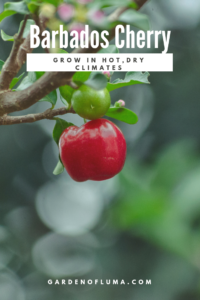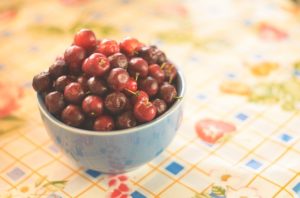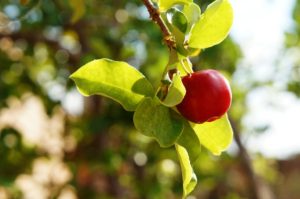Growing Acerola Cherry Tree (Barbados Cherry) in Hot, Dry Climates

I grew up in Traverse City, Michigan otherwise known as the cherry capital of the world. The climate in Michigan is drastically different than the Arizona desert where I reside now. I did a lot of research on the possibilities of growing a Cherry tree in my current climate, but it seems that Cherry trees just don’t work in the desert. I stumbled upon a gardener growing tropical cherry trees, which piqued my interest and I wanted to learn more about growing an Acerola Cherry tree or Barbados Cherry in hot, dry climates.
Although a Barbados Cherry or Acerola Tree has a cherry-like appearance it’s far from the traditional cherries that I was used to eating as a kid.
When trying new foods, it’s really easy to want to compare it to something that you have tasted before or are familiar with.
The name “cherry” brings with it an expectation of what a cherry should taste like.
Barbados Cherry is unique in its own way. I would describe its taste similar to a tangy fruit punch.
Growing Barbados Cherry or Acerola
A Barbados Cherry tree is a relatively vigorous growing tree in hot, dry climates like the desert.
Its growth habit is more like a large bush or shrub than a tree, somewhat similar to a pomegranates natural growth habit.
Like a Pomegranate tree, you could select a central leader and maintain pruning to form more of a tree shape.
I choose to just let my Barbados Cherry grow in its natural bush form. Barbados Cherry trees tend to fruit fairly quickly.
I purchased and planted a 3-gallon tree at my previous residence in the spring and it had its first fruits in late summer of the same year.
Barbados Cherry is really a versatile tree and can be planted in small or large spaces in the yard. It seems to be at home even in a dry climate with limited humidity.
When in bloom, a Barbados Cherry has attractive small pink blossoms. There are some variations with varieties which causes fruit to be variable in taste.
I’d recommend finding a reputable tropical fruit tree nursery that carries the Florida Sweet variety which produces the best tasting Barbados Cherries.

Fruit
Barbados cherries are best eaten when dark almost maroon red for maximum sweetness.
Barbados Cherries are known for having one of the highest vitamin c contents of any food, so I appreciate all the health benefits that come from eating Barbados cherries.
The Barbados cherries are generally about the same size as a traditional cherry while containing 1-3 soft seeds.
My Barbados cherry tree tends to fruit throughout the warm months and goes from flower to fruit in about 30 days.
Some potential health benefits of Acerola include:
- Antioxidant
- Healthier Skin
- Improve Digestion
- Anti-Cancer
- Help Boost Cardiovascular system
- Strengthen Immune System
- Improve Vision
- Promotes Healthy Brain
Gardening Skill Level
I would rate growing a Barbados Cherry tree as easy to moderate skill level for gardeners in hot, dry climates.
The only reason why I would say moderate is that it is sensitive to frost, which takes some extra consideration with care.
They can generally take some cold when mature, but I did lose a young tree to frost one year.
Suitable for Container Growing

Acerola Trees are great for growing in a container. If you are concerned about possible threats of frost, then growing it in a container can be a good way to go.
I’m currently growing my Acerola tree in a 15-gallon container and it is thriving. Be sure to plant in a container with a soil mix that allows good drainage and that the container has adequate drainage holes.
A full-size tree only gets to around 15-20 feet tall, so it’s easy to maintain at a smaller size for a container with pruning.
The tree can still produce a good amount of cherries in a container.
Planting Tips
Like all my fruit trees, having good drainage is a must.
If planting in clay soil, I would consider amending the soil take a look at my post “How to improve clay soil for fruit trees.”
It’s also beneficial to top the tree well with a generous amount of compost and mulch.
Watering
I water my Barbados Cherry consistently during the hot months.
Barbados Cherry doesn’t seem like it needs a ton of water or likes to be overly moist.
I wouldn’t allow it to dry out, but as long as it’s being watered on a regular basis it’ll flourish.
I slow down quite a bit on watering in the cooler temps.
Feeding
Barbados Cherries aren’t too demanding when it comes to feeding.
I feed my Barbados Cherry tree every two weeks since it is in a container with fish emulsion and liquid seaweed.
I also top dress with mulch and compost a few times throughout the year.
I apply a foliar feed of liquid seaweed and chelated iron every month or so.
Sun Exposure
Barbados Cherry trees can handle our full desert sun throughout the year.
As long as the tree is getting proper water, it seems to thrive in the full sun and grows all summer long.
This is one of the best things about growing a Barbados Cherry tree in hot climates is that you don’t need to worry too much about it getting the shade or having the right microclimate.
In fact, it fruits better in full sun. As long as it doesn’t freeze during the winter it’ll do well pretty much anywhere.
Potential Problems
Barbados Cherry trees don’t have very many potential problems.
I have noticed some issues with aphids on newer growth tips, but it can easily be remedied.
I haven’t seen any major problems with nutrient deficiencies or salt burn.
It seems like they can handle higher PH soils or clay soil types without much of an issue.
Please comment below on anything that you enjoyed about this post or anything related to growing Barbados Cherry trees.



I was told when the acerola is 2-3 years old, it’s tough enough to handle a lot of cold. Donno, but this is what I was told. But, did you try a capuli (school) cherry? AKA capulin. These are related to run cherries, but great. I don’t have one, and those I had were in Mexico. They’re cold hardy to Zone 7, and need to be watered thru the summer. From seed, they should produce in 3-4 years, and get about 40 ft tall. Good shade tree, plenty of long strings of blooms, and they’ll bloom again in August, if the season is long enough. They ripen about 2 weeks earlier than European cherries. I’ve been looking but no one seems to have them. Might pick some seeds up if Ican get to Mexico some time soon. niio!
I agree, they can take a bit more cold when they’re more mature. They’re still going to be sensitive to temps below freezing though. I’ve seen more mature trees bounce back if they suffer some cold damage.